We all know how much work goes into crabbing, and the rewards are usually a nice feed of otherwise unaffordable seafood gathered personally, which makes it even better. Then, there comes the element of thievery, those who think they should be able to reap the rewards of someone else’s hard work, expense and planning and straight out steal crabs from others pots, and often the pots as well.
One gentleman in particular had enough, and set a motion sensor activated game camera in the nearby foliage. This switched on individual didn’t only film the pots being raided once or twice but three times in one day by the same man. The footage was handed onto the authorities, which could lead to exceptionally serious repercussions, as the thief in question is a licensed Commercial Crabber.
Another pot thief got caught by the owner coming out of a drain with his pots, name tags clearly visible all nice and neatly stacked on the floor, and you can imagine the outcome of this one. It’s obvious that things are getting out of hand here, and I just cannot believe how many people have such little moral backbone that they think it is alright to commit this crime. People have had enough, and are now setting pots more as traps than anything else. If you suspect that someone may be pot robbing, take footage, photos or even just details of boats and registrations if possible and report it. It’s a daily story we hear at Akwa Pro Tackle, as angry customers walk through the door to spend more hard earned money to replace stolen pots.
Have a look on Facebook etc for name and shame crab robbery footage and photos, because apparently there are some pages about to kick into gear to name and shame the thieves – and it’s going to be a popular one.
Now for some good stuff, and the barra have put smiles on many faces smashing lures and baits fished at the right time in the right place. On the bigger tides the flats have been a great place to start the search, and some pretty big fish are getting involved. Both hardbodies and soft plastics are taking fish, and the bigger specimens seem to like the larger profiled noisier hardbodies as they are twitched alongside horizontal structure. It still amazes me how they find lures in the filthy water, but there is no denying the results, and more and more anglers are fine tuning their assault based on the tidal influences. There have been several boats stranded high and dry on the falling tides, which can be dangerous without enough water on board in the stinking heat on a day with no breeze. On many of the flats you’ll end up sinking to your knees in mud if you try to attempt to trek the couple of hundred meters to the shade of the mangroves. You’ll also end up battling the swarms of mosquitoes and sandflies, and that would send anyone insane.
Since the majority of the flow has eased from the fresh we had recently, there have been a lot of fish caught in the upper reaches of systems as well, and considering shrimp are high on the dietary rating of barra in these spots, it makes sense to use prawn imitations, even in the fresh at times. We experienced this recently on a bit of a walk-in session and while I couldn’t use my hardbodies that I usually use (due to the weed), we caught plenty of fish using weedless presentations. Strong weedless hooks had to be used in order to lift and slide the fish over the thick weed before releasing them, and as usual, the bite was best around the onset of darkness. Weedless presentations have become more and more established, and anglers’ rigging techniques much more finetuned to get the best hook-up ratio. Colour wise, iridescent and white colours have been the most consistent base colour, but the more pedantic anglers are now using the Quick Coat Worm Dip to customise their plastics as conditions dictate. For example, we got two orders of this stuff in recently and they both sold out in a couple of days.
I tend to use it more on the active type plastics that have flappy bits waving around in the water as they’re worked, and the contrast and attention they attract is obvious once you look at it in the water. Just remember that not all plastic materials are suitable for the Dip, and it will destroy some, while it just won’t penetrate other materials such as the ZMan rubbers. Stick to dipping your standard plastics.
Jacks are a little slower in the rivers but still hang around the river mouths, but I’d think that unless we get a heap of rain (not likely) they should start to work their way back towards the upper reaches again by the time you read this.
Some decent flathead are sitting in drains and ledges at the lower stages of the tide, and often intercept lures intended for barra. Salmon also school inside river mouths, and small prawn imitations account for many of these captures. While I’m not a fan of the blue salmon on the table, they are one of the most exciting fish to catch on light lines, and well worth casting at when you see them coming. If you do intend to keep one or two for a feed, make sure you have a good esky full of ice, as the flesh on the salmon can go soft quickly if it’s not cooled sufficiently.
Mackerel numbers gradually increased over the last few weeks, and they are in plague proportions in some spots. Good mate Karl Ramano went searching for some reds the other day and from the first bait that hit the bottom, the macks made their presence felt snipping off every offering, even when rigged on wire. It’s hard to know how long wire should be when they are thick like this, and it’s a fine line between too long and too short for me. Long traces stand out away from the mouth once a fish is hooked and give the rest of the school something to snap at while they compete and try to grab food items from each other’s mouths. Going shorter can have the bait taken too deeply and then snipped off by the first attacker. Around 100-150mm is a happy medium for me, and this goes for half pilchards rigged on a gang, and also on slugs and slices if you can’t avoid needing wire. Lighter wire seems to draw less attention too, and 20-30lb single strand is good for most fish. Whole pilchards aren’t needed on a gang of three or four hooks when they’re smashing everything, and the extra hooks on their own give other macks something to swipe at if they protrude from the jaw, whereas the double hook is usually inside the mouth and less of a target.
If you can find a deeper spot that’s not smothered in spotties and school macks, you should do well on table fish like large-mouth nannygai and reds. A few big cobia have shown up, and have taken baits meant for reds both day and night. Bigger baits such as the squid and cuttlefish produce the best results, and we have a handful of specialists now ordering the 6kg boxes of cuttlefish for their offshore escapades. Because of their thick fleshy type body, several fish can often be caught on the one bait before it’s gone or needs to be replaced. What you target depends on the way you rig cuttlefish, and if you’re doing the standard paternoster rig with say an 8/0 suicide or circle hook, you can usually get three baits from one small to medium cuttlefish. The head is the prime part, and if you remove the cuttle and slice the bait from the tip of the hood to the bottom of the hood you get two more thick baits.
Once it gets dark, I use them whole rigged on a two hook snelled rig and soft 80lb leader for bigger red fish. The stiffer fluorocarbon is great for lure fishing but spooks softer mouthed species like red emperor if they feel it, hence the soft mono for the baits.
I have always been guilty of packing too many outfits, lures, and so on when I head out, so the other day I decided that enough was enough – I was to take four outfits and no more. The aim of the game was to do some offshore soft plastic-ing, baitfishing, and maybe a little trolling. After a good hour of travel, we arrived at a mark that had a massive school of small macks on it and just couldn’t get bait past them so we looked at some other marks. These marks had all the usual less than desirable species on them, like little wire netting cod and pickers, so this didn’t work out either. The sun was getting higher now, and we decided to go and look for some shallower stuff to flick for trout and nannygai. You guessed it: I had nothing light enough and sat there thinking how much I could have done with another couple of rigs to fish properly. Struggling through with stuff that was meant for deeper water and heavy jigheads made it hard, but we did manage some fish for the table in the form of trout, nannies and grassies hopping the Atomic Prongs on 1/2oz heads around any little bumps and lumps we could find.
If you don’t need a feed and you’re more interested in chasing stuff that fights like hell, then the queenfish and trevally should keep you occupied. Both species are common by-catch when chasing bottom fish, and are an absolute handful on the lighter stuff. These encounters are sometimes long drawn out battles though, and can last over an hour, which does get a little tiring when you want to target other fish. Still, the challenge is real and greatly satisfying when you land a big fish on the light stuff.
Even though things aren’t going ballistic, there is enough going on to keep you busy. It may be a good time to check one of the spots you’ve been planning on getting around to, or a technique that you’ve wanted to try.
Cheers and good luck.
Reads: 1212
Young Tannhym confiscated my beloved Samurai Refraction as I drank from a bottle of water, as he couldn't reach the fish with his outfit. The extra distance allowed him to cast to the fish with ease and prove that he can mix it with the big boys.
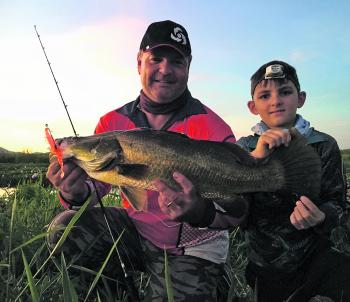
What a great time of day. This fish was just one of many taken in the last hour of light. As soon as the Paddle Prawn from Madeye was rigged on the weedless hook the action kicked off with the lure flicked just under the surface. Seven bites in seven cast
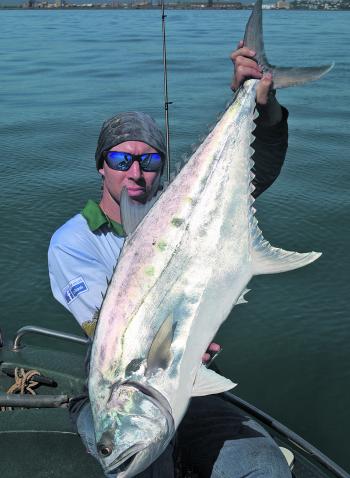
Some stonking big queenies are getting in on the action as well. This one ate Ryan Tully's tiny plastic on a light outfit, tying him up for just over an hour before being released.
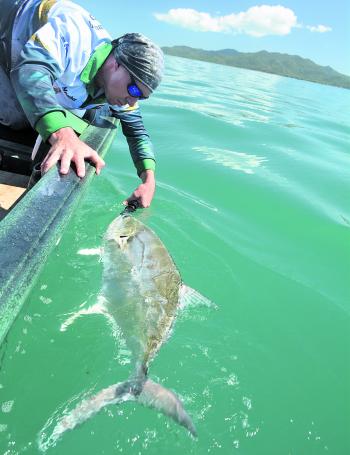
Ryan Tully releasing the big queenie to fight another day.
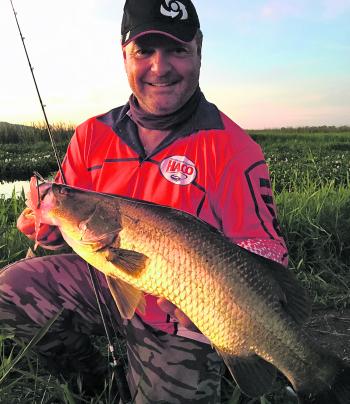
The mosquitoes of the north seem to love the taste of personal insecticides. No amount of spray seemed to make a difference, but the fishing was just great fun.
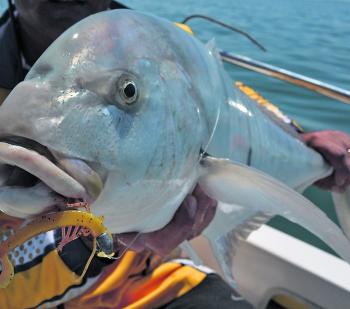
Even though many people think trevally are less than desirable, anything that pulls as hard as these things is worthy of a great deal of respect as a sporting fish.
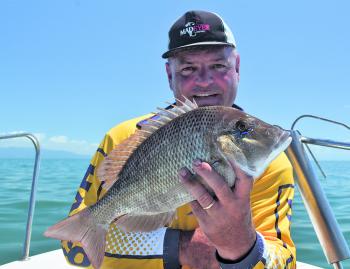
All of the weed beds near shallow reef presently hold good numbers of solid grassy sweetlip. These things pull like a runaway truck and are great tucker.
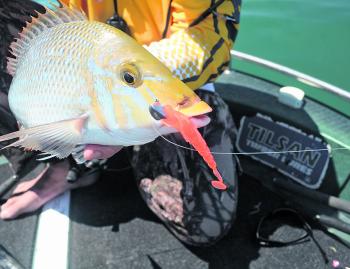
The Madeyes are still surprising us as to what they will catch and where they pull fish.




